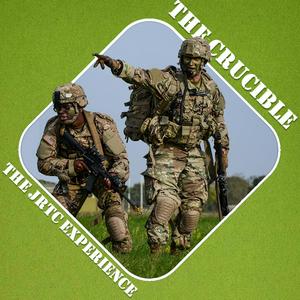117 S13 Ep 06 - Ammo, Assumptions, and the Artillery Fight: Lessons from the Box w/the JRTC Fires Support Task Force
The Joint Readiness Training Center is pleased to present the one-hundredth-and-seventeenth episode to air on ‘The Crucible - The JRTC Experience.’ Hosted by MAJ Marc Howle, the Brigade Senior Engineer / Protection Observer-Coach-Trainer, and MAJ David Pfaltzgraff, BDE S-3 Operations OCT, from Brigade Command & Control (BDE HQ) on behalf of the Commander of Ops Group (COG). Today’s guests are senior members of JRTC’s fires support enterprise: MAJ Jeff Horn, MSG Esteban Melendez, and SFC Larry Gillispie, Jr. MAJ Horn is the Executive Officer OCT for the Fires Support Task Force. MSG Melendez is the Battery Senior NCO OCT and SFC Gillispie is the Fires Direction Center Senior OCT for the Fires Support TF.
This episode centers on the critical role of indirect fires in enabling brigade and battalion maneuver during large-scale combat operations (LSCO). Discussion emphasized how modern battlefields—defined by continuous observation, rapid enemy counterfire, and contested electromagnetic terrain—demand faster, simpler, and more integrated fires processes. The episode explored the necessity of marrying intelligence, targeting, and maneuver to generate timely and accurate effects, noting that units frequently struggle with building effective EVENTEMPs, aligning priority intelligence requirements with high-payoff target lists, and ensuring fire support elements understand the commander’s visualization. Indirect fires are no longer a supporting arm that can be “plugged in” at the end of planning; instead, fires must lead maneuver, set conditions, disrupt enemy reconnaissance, and shape the tempo of operations. Units that succeeded at JRTC did so by developing disciplined fires rehearsals, maintaining digital pathways for observers and FSEs, and employing simple, survivable fire support plans that could be executed under degraded conditions.
The episode also examined common shortfalls in fire support execution and provided practical solutions rooted in LSCO best practices. Many units struggled to connect sensors to shooters, often due to poor task organization, inconsistent digital connectivity, or a lack of rehearsed triggers and decision points. The conversation stressed that fires must be integrated early, beginning at WARNO 1, so that reconnaissance, counter-reconnaissance, and targeting all feed a coherent fires architecture. Leaders must enforce conditions that enable fires in contact: dispersed artillery positions, rapid survivability moves, redundant communications, and timely, accurate reporting. Best practices discussed included using decoys to force enemy action, leveraging sUAS for battle damage assessment and real-time refinement, simplifying TLWS/TTLODAC products, and conducting thorough fires technical rehearsals. Ultimately, the episode reinforced that mastery of indirect fires is inseparable from mastery of LSCO itself—units that can sense, decide, and deliver effects faster than the enemy preserve freedom of maneuver and dominate the fight.
Part of S13 “Hip Pocket Training” series.
For additional information and insights from this episode, please check-out our Instagram page @the_jrtc_crucible_podcast
Be sure to follow us on social media to keep up with the latest warfighting TTPs learned through the crucible that is the Joint Readiness Training Center.
Follow us by going to: https://linktr.ee/jrtc and then selecting your preferred podcast format.
Again, we’d like to thank our guests for participating. Don’t forget to like, subscribe, and review us wherever you listen or watch your podcasts — and be sure to stay tuned for more in the near future.
“The Crucible – The JRTC Experience” is a product of the Joint Readiness Training Center.


